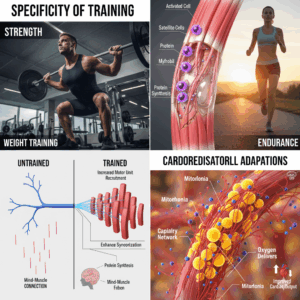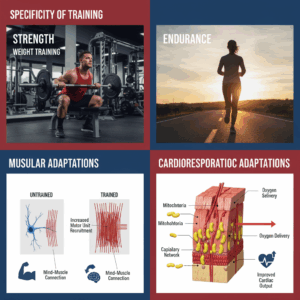
Why does weight training improve muscular strength more than cardiorespiratory fitness? The Science Behind Your Gains
In the realm of fitness, two giants stand out: weight training (or strength training) and cardiorespiratory (or aerobic) fitness. Both are crucial for overall health, yet they contribute to your body in fundamentally different ways. While a long run might leave you breathless and strong, it won’t give you the same bulging biceps as lifting heavy. Similarly, deadlifting your body weight won’t prepare you for a marathon. The question often arises: why does weight training specifically improve muscular strength more effectively than cardiorespiratory fitness?
To truly understand this, we need to delve into the fascinating physiological adaptations that occur within our bodies in response to different types of stress. This blog post will explore the distinct mechanisms by which weight training sculpts stronger muscles, contrasting them with the adaptations driven by cardio, and highlighting why specializing in one yields superior results for its intended purpose.
The Fundamental Principle: Specificity of Training

At the heart of why weight training excels at building muscular strength is the principle of specificity. This foundational concept in exercise science states that your body adapts specifically to the demands placed upon it. If you want to get better at lifting heavy objects, you must lift heavy objects. If you want to improve your endurance over long distances, you must engage in sustained aerobic activity.
Your body is an incredibly efficient machine. It doesn’t waste resources building adaptations you don’t specifically train for. This means:
- Weight training imposes a high-intensity, short-duration mechanical stress on muscle fibers.
- Cardiorespiratory training imposes a moderate-intensity, long-duration metabolic stress on your cardiovascular system and muscles.
These different types of stress trigger entirely different cascades of cellular and systemic adaptations.
The Muscular Adaptations to Weight Training: Hypertrophy and Neuromuscular Efficiency
Weight training is designed to overload your muscles, forcing them to adapt and become stronger. This primarily happens through two key mechanisms:
1. Muscular Hypertrophy (Muscle Growth)
This is perhaps the most visible and well-known adaptation to weight training. When you lift weights, you create microscopic tears in your muscle fibers. In response to this damage, your body initiates a repair process that not only fixes the damaged fibers but also makes them bigger and stronger to better withstand future stress.
- Satellite Cells: These are dormant cells located on the outer surface of muscle fibers. When muscle damage occurs, satellite cells are activated. They proliferate, fuse with existing muscle fibers, and donate their nuclei, allowing the muscle fiber to produce more protein and grow in size.
- Increased Protein Synthesis: Weight training stimulates the pathways responsible for synthesizing new muscle proteins (actin and myosin). These proteins are the contractile elements of muscle, and increasing their quantity leads to thicker muscle fibers.
- Sarcoplasmic vs. Myofibrillar Hypertrophy:
- Myofibrillar Hypertrophy: This involves an increase in the number and size of the contractile protein filaments (myofibrils) within the muscle cell. This leads to denser, stronger muscles and is largely responsible for significant strength gains.
- Sarcoplasmic Hypertrophy: This involves an increase in the volume of sarcoplasm (the fluid around the myofibrils) and non-contractile elements like glycogen, mitochondria, and water. While it contributes to muscle size, it contributes less directly to absolute strength. Weight training protocols often target a mix of both, but myofibrillar hypertrophy is key for strength.

Muscular strength isn’t just about big muscles; it’s heavily influenced by how effectively your brain communicates with your muscles. Weight training significantly improves this “mind-muscle connection.”
- Increased Motor Unit Recruitment: A motor unit consists of a motor neuron and all the muscle fibers it innervates. With training, your nervous system learns to activate a greater number of motor units simultaneously, allowing you to recruit more muscle fibers at once.
- Improved Firing Frequency: Your brain learns to send signals to your muscles more rapidly, allowing for quicker and more forceful contractions.
- Enhanced Synchronization: Motor units that are normally activated asynchronously become more synchronized, leading to a more powerful, coordinated muscle contraction.
- Reduced Antagonist Co-activation: Your body learns to relax opposing muscles (antagonists) more efficiently during a movement, allowing the primary muscles (agonists) to contract with greater force.
READ ALSO Why does weight training improve muscular strength more than cardiorespiratory fitness?
These neurological adaptations occur relatively quickly when you start weight training and are responsible for a significant portion of initial strength gains, even before much visible muscle growth occurs.
The Adaptations to Cardiorespiratory Fitness: Endurance and Efficiency
Cardiorespiratory fitness, while beneficial for whole-body health, drives very different adaptations that are geared towards sustained activity, not maximal force production.
- Mitochondrial Biogenesis: Aerobic training significantly increases the number and size of mitochondria within muscle cells. Mitochondria are the “powerhouses” of the cell, responsible for producing ATP (cellular energy) using oxygen. More mitochondria mean greater aerobic capacity and fatigue resistance.
- Capillarization: Cardio training leads to an increase in the density of capillaries (tiny blood vessels) surrounding muscle fibers. This improves the delivery of oxygen and nutrients to the muscles and the removal of metabolic waste products, enhancing endurance.
- Improved Cardiac Output: The heart muscle itself adapts, becoming stronger and more efficient. Stroke volume (the amount of blood pumped with each beat) increases, leading to a lower resting heart rate and better blood flow throughout the body.
- Enhanced Oxygen Utilization: Your body becomes more efficient at extracting and utilizing oxygen from the blood at the muscular level.

These adaptations allow you to perform sustained activities for longer periods without fatigue, but they do not directly contribute to the ability of a muscle to produce maximum force. In fact, excessive endurance training can sometimes even interfere with pure strength and muscle growth signals.
Why Cardio Doesn’t Build Strength Like Weights
While all movement builds some level of strength, cardiorespiratory activities like running, cycling, or swimming are inherently designed to tax your cardiovascular system and slow-twitch muscle fibers (Type I) which are geared for endurance.
- Lower Resistance, Higher Repetitions: Cardio typically involves moving a lighter load (often just your body weight, or minimal resistance) for a very high number of repetitions. This doesn’t provide the sufficient mechanical tension and progressive overload required to stimulate significant myofibrillar hypertrophy or recruit high-threshold motor units necessary for maximal strength gains.
- Focus on Energy Systems: The primary adaptations from cardio are metabolic – improving how your body produces and uses energy efficiently over time. This is different from the mechanical adaptations of muscle fiber thickening and neurological recruitment.
- Muscle Fiber Type: Cardio primarily trains Type I (slow-twitch) muscle fibers, which are highly resistant to fatigue but produce less force. Weight training, especially with heavier loads, preferentially recruits and grows Type II (fast-twitch) muscle fibers, which are powerful but fatigue quickly. These are the fibers most responsible for maximal strength.
The Synergistic Relationship: Why Both Are Essential
Despite their distinct benefits, weight training and cardiorespiratory fitness are not mutually exclusive; they are complementary.
- Cardio for Recovery: A strong cardiovascular system improves blood flow, which aids in nutrient delivery and waste removal from muscles, potentially enhancing recovery from weight training.
- Strength for Cardio: Stronger muscles can improve efficiency in endurance activities, allowing you to run or cycle faster with less effort, or maintain form for longer.
- Overall Health: Both reduce the risk of chronic diseases, improve bone density, enhance mood, and contribute to a higher quality of life.
Conclusion: Train for Your Goal
The answer to why weight training improves muscular strength more than cardiorespiratory fitness lies in the fundamental principle of specificity. Our bodies are marvels of adaptation, evolving precisely to meet the demands we place upon them. Weight training provides the unique mechanical tension and neurological challenges required to stimulate muscle fiber growth (hypertrophy) and enhance the nervous system’s ability to activate those muscles (neuromuscular efficiency).
While cardiorespiratory fitness builds incredible endurance and optimizes the efficiency of our heart and lungs, it simply doesn’t send the same signals to the muscles that trigger maximal strength development. To get stronger, you must lift heavy; to improve endurance, you must sustain effort. Understanding these distinct physiological pathways allows us to train intelligently, efficiently, and effectively for our specific fitness goals, building a truly well-rounded and healthy body.

Leave a Reply